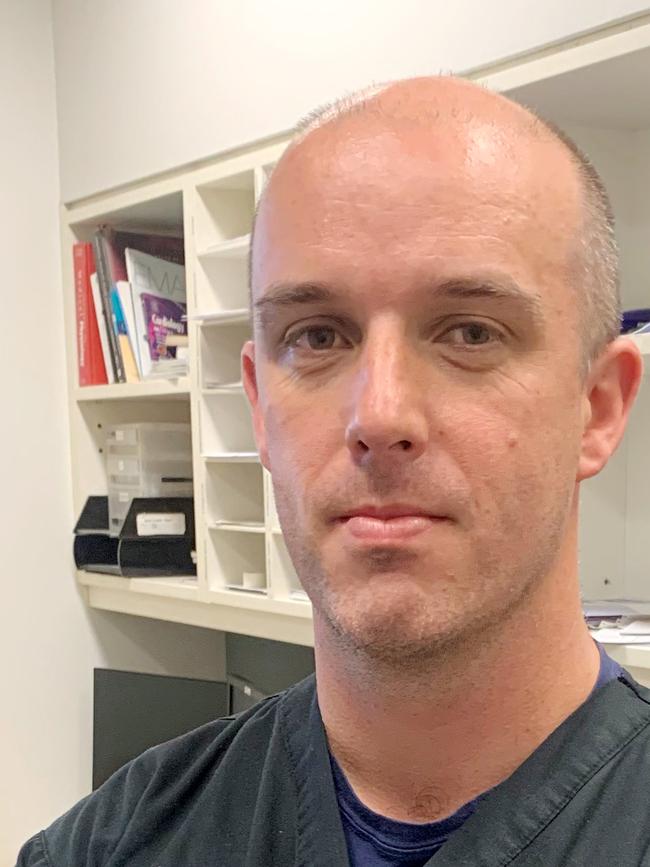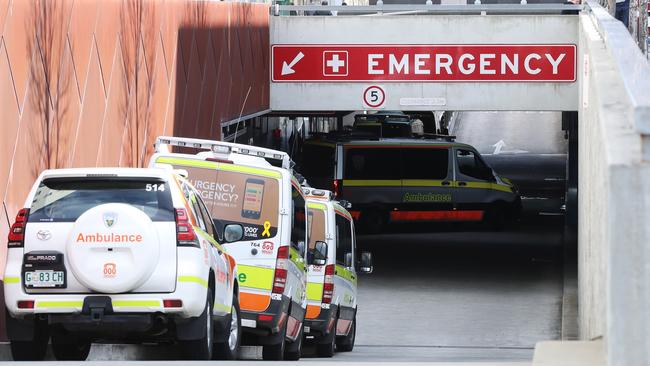Sick baby’s agonising 27-hour wait in jammed Tasmanian emergency department cubicle
“I have doctors and nurses regularly break down in tears because of the turmoil of not being able to help the disorientated elderly woman or the little baby,” a Hobart ED doctor has revealed as he slams the ‘severe bottlenecks’ plaguing our hospitals.
Tasmania
Don't miss out on the headlines from Tasmania. Followed categories will be added to My News.
TASMANIANS, if you were to seek help at any Tasmanian emergency department today, it will likely be stressful the moment you come in the door.
You will ask us, “How long will I be waiting?” and we won’t be able to give you a clear answer. Because we never know what might come into Emergency, and because of the severe bottlenecks facing patients at all Tasmanian EDs.

We call these bottlenecks “access block”. Access block is when a combination of not enough medical staff, resources and procedural issues leads to delays in admitting patients to hospital from the ED and in admitting to a bed in a ward. Access block leads to ED crowding, ambulance ramping and longer waits. It is dangerous for all patients and it is deeply distressing and frustrating for healthcare workers.
So, because of this issue, it is likely you will wait in the crowded ED. You may wait alongside sick babies with their worried parents.
Sometimes we can’t even assess the baby right away. We try so hard, but we have too many patients, and not enough physical space or staff. Then, when we know they need a hospital bed, there are not enough of those.
You may wait alongside grandparents who have come in with delirium, or a fractured hip. They may have to sit in the brightly lit waiting room for hours, without sleep. They often become agitated and confused as they’ve been there for so long, they can’t tell what time it is. This hurts us: these people have come to us for help and instead they are being harmed.
In these times, we can always feel that the patient and the family think that not enough is being done. We can feel it.

We stand and look out at the packed waiting room, and the ramped ambulances, and it is like an ocean in front of us. It is overwhelming. We can see to the other side, but we cannot get to them. Every person – from the doctors and nurses to the aides and the cleaner – wants to do better for the patients and their families.
After we finally get to assess you, if we decide you need to be admitted to the hospital, due to access block, you, or the baby, or the grandparent, can remain stuck – for hours or even days – in the ED waiting for a bed.
Recently, we had a baby waiting in a cubicle for 27 hours. This is awful for the baby, for the parents – and it is using up a bed in the ED that means there is no space for the next sick baby to be assessed.
It wasn’t too long ago that things were different. Ten years ago, if you came into a Tasmanian ED, you would rarely wait for longer than four hours. Ambulances would drop their patients off to the cubicles or to resus. The doctors and nurses would greet you, and immediately assess you. If you needed to be admitted, you would be sent up to the wards with few delays. This is how it should look now.
So what happened?

The government did not plan for the future. They did not plan for the ageing population or support primary care enough; they didn’t create enough community or mental health services.
Now I have doctors and nurses regularly break down in tears in front of me. Because of the emotional turmoil of not being able to help the disorientated elderly woman, or the little baby and their parents.
These are healthcare workers that are being held back by things we can’t control. It is slowly eating away at all of us. Because we know that we can do better. And we know that Tasmanians deserve better.
Tasmanians, you have a chance to control this. This election, we urge you to demand more from the parties tasked with serving you. This is the time they may listen – they want your vote.
Demand that they commit to your health. And not just for one or two years, but for the long term — demand a long-term plan with a whole-of-system approach. Tell the parties that they must address the insidious systemic issues that lead to access block.
Fixing access block can lead to an ease in ramping and overcrowding. Tell them that they must set a timeline for fixing these problems and hold themselves accountable.
At the very least, Tasmanians deserve the same quality of care as on the mainland. To get there, tell your politicians that we need another 100 general medical beds in the next year and a total of 300 by 2024. These must be also staffed and resourced to stay open.
We can get back to the ideal where no-one experiences unreasonable waits.
Because you should not have to wait when you come to an ED.
It is, quite literally, life and death.
Tell your politicians: “We can’t wait.”
Dr Juan Ascencio-Lane is an emergency doctor based in Hobart, and the Tasmanian Faculty chair of the Australasian College for Emergency Medicine.


